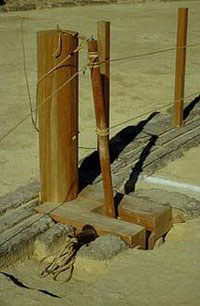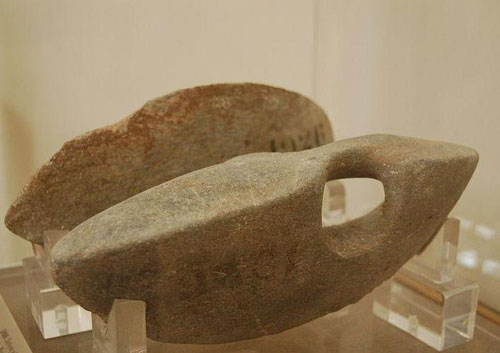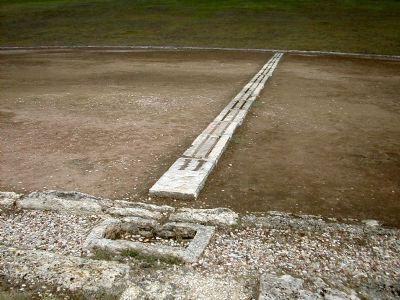6.2 Pentathlon
The pentathlon closed the sporting spectacles of the second day in the Ancient Olympics. In Classical Greek, pentathlon means 'five competitions'. These five events were the jump, discus, foot race, javelin throw and wrestling. Only one prize was awarded and each pentathlete was expected to participate in every one of the five events in order to be eligible for the award. Unlike equestrian events, the pentathlon clearly embodied the spirit of the Ancient Olympics. There was little ostentation or snobbery, and competitions were carried out with a minimal amount of paraphernalia (even the sporting grounds were stripped of any unnecessary adornments, leaving little more than a simple dug out area on the stadion surface in most cases). Pentathlon competitors required a broad range of skills in order to suceed in all five events, as well as a combination of physical prowess and psychological strength and endurance, which appealed particularly to the Ancient Greek principle of kalokagathia.
Jump
The jump event (halma), was similar to our modern version of the long jump, with some exceptions. The athletes jumped to the rhythm of music, probably played by an aulos (flute), which suggests that there may have been an element of choreography involved. They stood a short distance away from a small board (called bater) and stretched both arms out. Then they leaned back, ran forward and jumped from the board, keeping both legs together in the air, onto a shallow pit dug into the stadion surface. This pit, called the skamma, was full of loose soil (but probably not sand).
Animation 3 jump using halteres
One significant difference between the halma and the modern long jump is that Ancient Olympic athletes used a pair of weights called halteres. The halteres (which were also used as dumbbells during an athlete's training) were made of stone or metal. They could be long or spherical and did not have a standard weight. During the halma, they were carried by the jumper in front of him, thrust backward just before the jump and dropped in the descent, apparently to increase the distance of the jump. It is unclear whether the halteres really offered any physical advantage during the jump. Modern athletes have attempted to reconstruct the Ancient Olympic halma using halteres, but only worse results have been achieved with the use of weights.
Discus
Like the halma, the discus throw involved precision and rhythm as well as strength, and was probably conducted to the accompaniment of music. This athletic event was a favourite subject of Ancient Greek sculptors and vase painters, who have left us with many representations of this particular competition. Unlike the modern Olympic version, Ancient Greek discus throwers did not spin on their own axis before the throw. They started by bringing their left foot forward and shifting the weight of their body to their right side whilst holding the discus upfront with both hands at head level. With their right hand they swung the discus a few times back and forth by their side, turned their body with the movement of the swing and finally threw the discus straight ahead. It seems that the shape and weight of the discus were not standardised (although we do know that younger competitors always used a lighter version). The discuses that have been found are made of stone or metal (frequently bronze) and weigh between 2 and 2.5 kilos.
Animation 4 discus throw
Foot races
Running is the oldest known competition of the Ancient Olympics. There were four events in this discipline at Olympia: the stadion race, which consisted of a sprint of about 192 metres (i.e. one lap around the stadion); the diaulos, which translates literally as 'double flute' and consisted of a double-stadion race; the dolichos, a long race of approximately 7.5 to 9 kilometres; and the hoplitodromos, an unusual race introduced in the 6th century BCE in which athletes dressed in military armour (helmet, large shield and, originally, shin guards – weighing in total some 30 kilograms) and ran two laps around the stadion. There was no marathon race (this was only introduced in the modern Olympics). Foot races were particularly exciting spectacles for the audience, who stood on the slopes at either side of the stadion, about an arm's length from the athletes. Just like the equestrian games, a specially-designed starting mechanism was used in all foot races. It was called the hysplex, and it consisted of a set of hinged gates operated from the distance by the Hellanodikes, who would pull a cord in order to allow all runners to start simultaneously.
How does that sound to you?: the hysplex

Javelin throw
The level of success of a javelin throw was, like the discus throw and the halma, assessed on the basis of the distance achieved, but also the athlete's precision and rhythm. The javelin (akon) was thin and light and had approximately the same length as a man. It was made of wood (frequently elder wood) and had a small, sharp metallic tip. Much like its modern Olympic equivalent, the throw began with the javelin held at the athlete's shoulder level. The athlete gripped the javelin's shaft with his right hand and held the tip with the left hand. He stepped forward (there was probably no running) and then threw the javelin straight ahead as far as possible. Unlike the modern javelin throw, the Ancient Olympic akon was thrown with the use of a leather strap called an ankyle. The ankyle was wrapped around the javelin (close to its centre of gravity) and held between two of the athlete's fingers in a loop. During the last stage of the throw, the ankyle would be quickly unwrapped (which had the effect of artificially extending the athlete's arm), increasing the javelin's rotation (thus making it more stable in the air) and accelerating the projectile over a longer distance.
Animation 5 javelin throw
Wrestling
Wrestling (pale) was divided into two types in the pentathlon – orthia pale (which translates as 'upright wrestling') and kato pale (i.e. ground wrestling). The aim of orthia pale was to throw one's opponent on his hip, shoulder, or back. Three fair falls were required to win a match. Athletes started the fight in a position called systasis (i.e. 'standing together'), which involved leaning against each other with their foreheads touching. In kato pale, which was fought in a crouched position, opponents wrestled until one of them acknowledged defeat (which was signalled by holding up one's right hand with the index finger extended). Pale matches were fought in a simple, shallow pit (the skamma) dug into the surface of the stadion. Although opponents were broadly divided into different groups according to age, there were no specific weight classes. Competitors were expressly forbidden from punching, grabbing the opponent's genitals, biting, tripping, breaking the opponent's fingers or eye gouging. A Hellanodikes observed the fight at close range, ready to use his rhabdos in case one of the competitors infringed the rules. Pale was associated with the mythological character Palaestra, daughter of Hermes. According to Philostratus the Elder (II.32), she was a short-haired, feisty woman capable of beating almost anyone in a wrestling match. ‘Palaestra’ was also the name given to the area of a gymnasion used to train wrestlers.
Animation 6 wrestling
Once all five events had been held, the winner of the pentathlon was announced by a herald. This was a dramatic moment. The victor was awarded a ribbon (tainia) and a palm branch (klados phoinikos) and paraded around the stadion as the crowd cheered and threw flowers and ribbons. The losers quietly retired and the day ended with sacrifices at the shrine of Pelops.


